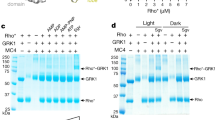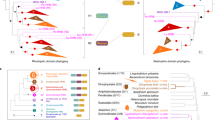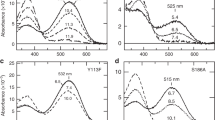Abstract
Invertebrate phototransduction uses an inositol-1,4,5-trisphosphate signalling cascade in which photoactivated rhodopsin stimulates a Gq-type G protein, that is, a class of G protein that stimulates membrane-bound phospholipase Cβ. The same cascade is used by many G-protein-coupled receptors, indicating that invertebrate rhodopsin is a prototypical member. Here we report the crystal structure of squid (Todarodes pacificus) rhodopsin at 2.5 Å resolution. Among seven transmembrane α-helices, helices V and VI extend into the cytoplasmic medium and, together with two cytoplasmic helices, they form a rigid protrusion from the membrane surface. This peculiar structure, which is not seen in bovine rhodopsin, seems to be crucial for the recognition of Gq-type G proteins. The retinal Schiff base forms a hydrogen bond to Asn 87 or Tyr 111; it is far from the putative counterion Glu 180. In the crystal, a tight association is formed between the amino-terminal polypeptides of neighbouring monomers; this intermembrane dimerization may be responsible for the organization of hexagonally packed microvillar membranes in the photoreceptor rhabdom.
This is a preview of subscription content, access via your institution
Access options
Subscribe to this journal
Receive 51 print issues and online access
$199.00 per year
only $3.90 per issue
Buy this article
- Purchase on Springer Link
- Instant access to full article PDF
Prices may be subject to local taxes which are calculated during checkout





Similar content being viewed by others
References
Oldham, W. M. & Hamm, H. E. Heterotrimeric G protein activation by G-protein-coupled receptors. Nature Rev. Mol. Cell Biol. 9, 60–71 (2008)
Hubbard, R. & St George, R. C. The rhodopsin system of the squid. J. Gen. Physiol. 41, 501–528 (1958)
Yarfitz, S. & Hurley, J. B. Transduction mechanisms of vertebrate and invertebrate photoreceptors. J. Biol. Chem. 269, 14329–14332 (1994)
Shichida, Y. & Imai, H. Visual pigment: G-protein-coupled receptor for light signals. Cell. Mol. Life Sci. 54, 1299–1315 (1998)
Terakita, A., Yamashita, T., Tachibanaki, S. & Shichida, Y. Selective activation of G-protein subtypes by vertebrate and invertebrate rhodopsins. FEBS Lett. 439, 110–114 (1998)
Hara-Nishimura, I. et al. Cloning and nucleotide sequence of cDNA for rhodopsin of the squid Todarodes pacificus. FEBS Lett. 317, 5–11 (1993)
Williamson, M. P. The structure and function of proline-rich regions in proteins. Biochem. J. 297, 249–260 (1994)
Ashida, A., Matsumoto, K., Ebrey, T. G. & Tsuda, M. A purified agonist-activated G-protein coupled receptor: truncated octopus acid metarhodopsin. Zoolog. Sci. 21, 245–250 (2004)
Murakami, M., Kitahara, R., Gotoh, T. & Kouyama, T. Crystallization and crystal properties of squid rhodopsin. Acta Crystallogr.F 63, 475–479 (2007)
Venien-Bryan, C. et al. Effect of the C-terminal proline repeats on ordered packing of squid rhodopsin and its mobility in membranes. FEBS Lett. 359, 45–49 (1995)
Saibil, H. & Hewat, E. Ordered transmembrane and extracellular structure in squid photoreceptor microvilli. J. Cell Biol. 105, 19–28 (1987)
Liang, Y. et al. Organization of the G protein-coupled receptors rhodopsin and opsin in native membranes. J. Biol. Chem. 278, 21655–21662 (2003)
Davies, A. et al. Three-dimensional structure of an invertebrate rhodopsin and basis for ordered alignment in the photoreceptor membrane. J. Mol. Biol. 314, 455–463 (2001)
Palczewski, K. et al. Crystal structure of rhodopsin: A G protein-coupled receptor. Science 289, 739–745 (2000)
Okada, T. et al. The retinal conformation and its environment in rhodopsin in light of a new 2.2 Å crystal structure. J. Mol. Biol. 342, 571–583 (2004)
Li, J. et al. Structure of bovine rhodopsin in a trigonal crystal form. J. Mol. Biol. 343, 1409–1438 (2004)
Cherezov, V. et al. High-resolution crystal structure of an engineered human β2-adrenergic G protein-coupled receptor. Science 318, 1258–1265 (2007)
Rasmussen, S. G. F. et al. Crystal structure of the human β2 adrenergic G-protein-coupled receptor. Nature 450, 383–387 (2007)
Horn, F. et al. GPCRDB: an information system for G protein-coupled receptors. Nucleic Acids Res. 26, 275–279 (1998)
Doi, T., Molday, R. S. & Khorana, H. G. Role of the intradiscal domain in rhodopsin assembly and function. Proc. Natl Acad. Sci. USA 87, 4991–4995 (1990)
Nakagawa, M. et al. How vertebrate and invertebrate visual pigments differ in their mechanism of photoactivation. Proc. Natl Acad. Sci. USA 96, 6189–6192 (1999)
Ota, T. et al. Structural changes in the Schiff base region of squid rhodopsin upon photoisomerization studied by low-temperature FTIR spectroscopy. Biochemistry 45, 2845–2851 (2006)
Morizumi, T., Imai, H. & Shichida, Y. Y. Direct observation of the complex formation of GDP-bound transducin with the rhodopsin intermediate having a visible absorption maximum in rod outer segment membranes. Biochemistry 44, 9936–9943 (2005)
Urizar, E. et al. An activation switch in the rhodopsin family of G protein-coupled receptors. J. Biol. Chem. 280, 17135–17141 (2005)
Hamm, H. E. et al. Site of G protein binding to rhodopsin mapped with synthetic peptides from the alpha subunit. Science 241, 832–835 (1988)
Jander, P., Daumer, K. & Waterman, T. H. Polarized light orientation by two hawaiian decapod cephalopods. J. Comp. Physiol. A 46, 383–394 (1963)
Saidel, W. M., Shashar, N., Schmolesky, M. T. & Hanlon, R. T. Discriminative responses of squid (Loligo pealeii) photoreceptors to polarized light. Comp. Biochem. Physiol. A 142, 340–346 (2005)
Saibil, H. R. An ordered membrane-cytoskeleton network in squid photoreceptor microvilli. J. Mol. Biol. 158, 435–456 (1982)
Naito, T., Nashima-Hayama, K., Ohtsu, K. & Kito, Y. Photoreactions of cephalopod rhodopsin. Vision Res. 21, 935–941 (1981)
Provencio, I. et al. Melanopsin: An opsin in melanophores, brain, and eye. Proc. Natl Acad. Sci. USA 95, 340–345 (1998)
Matsui, Y. et al. Specific damage induced by X-ray radiation and structural changes in the primary photoreaction of bacteriorhodopsin. J. Mol. Biol. 324, 469–481 (2002)
DeLano, W. L. The PyMOL Molecular Graphics System. 〈http://www.pymol.org〉 (2002)
Bailey, S. The CCP4 suite: programs for protein crystallography. Acta Crystallogr. D 50, 760–763 (1994)
Baker, N. A. et al. Electrostatics of nanosystems: Application to microtubules and the ribosome. Proc. Natl Acad. Sci. USA 98, 10037–10041 (2001)
Kito, Y., Naito, T. & Nashima, K. Purification of squid and octopus rhodopsin. Methods Enzymol. 81, 167–171 (1982)
Suzuki, T., Uji, K. & Kito, Y. Studies on cephalopod rhodopsin: photoisomerization of the chromophore. Biochim. Biophys. Acta 428, 321–338 (1976)
Okada, T., Takeda, K. & Kouyama, T. Highly selective separation of rhodopsin from bovine rod outer segment membranes using combination of divalent cation and alkyl (thio) glucoside. Photochem. Photobiol. 67, 495–499 (1998)
Steller, I., Bolotovsky, R. & Rossmann, M. G. An algorithm for automatic indexing of oscillation images using Fourier analysis. J. Appl. Crystallogr. 30, 1036–1040 (1997)
Brunger, A. T. et al. Crystallography & NMR system: A new software suite for macromolecular structure determination. Acta Crystallogr. D 54, 905–921 (1998)
McRee, D. E. Practical Protein Crystallography (Academic, San Diego, 1993)
Acknowledgements
This work was supported by Grant-in-Aids from the Ministry of Education, Science and Culture of Japan and partly by the National Project on Protein Structural and Functional Analyses.
Author Contributions T.K. and M.M. designed the project. M.M. performed all experiments. T.K. assisted in data collection and structure determination. T.K. and M.M. jointly wrote the manuscript.
Author information
Authors and Affiliations
Corresponding author
Supplementary information
Supplementary information
The file contains Supplementary Tables S1-S2, Figure S1 and Legends. Supplementary Table S1 includes X-ray data collection and refinement statistics. Supplementary Table S2 shows the distances to the closest atoms of all amino acids around the retinal. Supplementary Figure S1 shows the multiple sequence alignment of squid and bovine rhodopsins. (PDF 371 kb)
Rights and permissions
About this article
Cite this article
Murakami, M., Kouyama, T. Crystal structure of squid rhodopsin. Nature 453, 363–367 (2008). https://doi.org/10.1038/nature06925
Received:
Accepted:
Issue Date:
DOI: https://doi.org/10.1038/nature06925
This article is cited by
-
RNA-seq analysis reveals changes in mRNA expression during development in Daphnia mitsukuri
BMC Genomics (2024)
-
Amino acid residue at position 188 determines the UV-sensitive bistable property of vertebrate non-visual opsin Opn5
Communications Biology (2022)
-
Convergent evolutionary counterion displacement of bilaterian opsins in ciliary cells
Cellular and Molecular Life Sciences (2022)
-
Genomic and Transcriptomic Analyses of Bioluminescence Genes in the Enope Squid Watasenia scintillans
Marine Biotechnology (2020)
-
The counterion–retinylidene Schiff base interaction of an invertebrate rhodopsin rearranges upon light activation
Communications Biology (2019)
Comments
By submitting a comment you agree to abide by our Terms and Community Guidelines. If you find something abusive or that does not comply with our terms or guidelines please flag it as inappropriate.



